Noble Corsair "Emden"
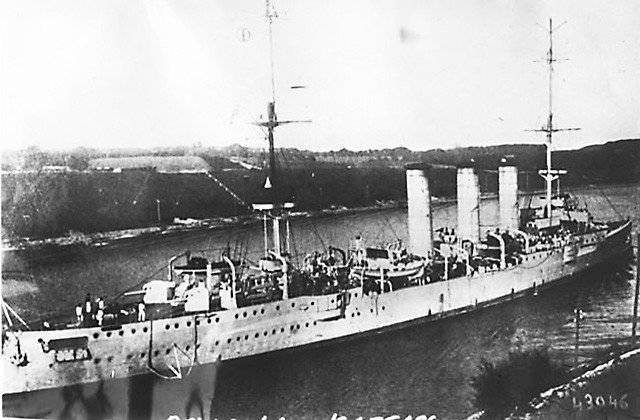
History the most famous German raider of the Great War
Light cruiser Emden of the German imperial fleet without exaggeration, one of the most famous warships of the Great War can be considered. His battle path to be short-lived - just a little over three months. But during this time he accomplished the seemingly impossible. Under the command of the young captain Karl von Müller, the ship, leaving the German naval base in Qingdao, passed through two oceans - the Pacific and the Indian, destroying 23 enemy vehicles, a cruiser and a destroyer in this raid. The actions of Emden became a model of a bold and successful cruising war, having temporarily disrupted British maritime trade in the Indian Ocean. At the same time, the crew of Emden strictly observed not only the laws and customs of war, but also chivalric traditions - the Germans did not kill and did not leave any captured sailor or passenger in the ocean to their fate. With his scrupulous attitude to the high concept of officer honor, 2nd-Class Captain Karl von Muller earned the honorary title of "last gentleman of the war" in world naval history, which was never disputed by any of his enemies.
A child of burgher patriotism
The light cruiser "Emden" to the beginning of the Great War was both new and old ship. New - on the time of enrollment in the combat structure of the German Navy, July 10 1910. Old - by design features, which inevitably affected its nautical qualities.
In the German system, the Emden naval classification was considered the 4-class cruiser - the easiest and most lightly armed. It was laid on 6 on April 1906 of the year in Danzig and was built, by German standards, for a very long time - more than 3 years. At the time of laying the ship called "Ersatz-Pfeil." But almost immediately the problems with financing began, and so serious that the Dresden of the same type, which was laid almost a year later, was launched earlier. The decisive role in the fate of the ship was played by the patriotic people of Lower Saxony - among the burghers of the city of Emden, by subscription, 6,8 million marks were missing for the completion of the ship. As a sign of gratitude, the new ship was called the "Emden".
Already outgoing shipbuilding solutions were applied in its design. So, for example, in the case set of the ship mild (low-carbon) Siemens-Martin steel was widely used. In addition, the "Emden" was the latest German cruiser, equipped with a classic-type steam engine. All cruisers of a later stage, including even the Dresden of the same type, had a steam turbine, which, at the same level of energy consumption, allowed to deliver significantly more power to the ship's propeller shaft.
The Emden steam engine caused the cruiser to deliver a maximum stroke only at the 24 of the node (44,45 km / h) with external circuits, which were almost ideal in terms of high speed. At the beginning of the 20th century, such a speed for a light cruiser was already insufficient, which ultimately played a fatal role in the fate of the Emden.
Emden’s armament was not very powerful: at full displacement in 4268 tons, the cruiser was armed with 10 guns of medium caliber 105-mm. There were still 8 cannon caliber 52-mm, but they were useless in the case of inter-ship artillery duels. For comparison: the Russian squadron “Novik” launched in 1911, almost three times smaller displacement - 1360 tons, was armed with four 102-mm cannons and four two-tube 457-mm torpedo tubes. Against this background, the Russian "Novik" Emden torpedo armament looked almost helpless - two single-tube submarine torpedo tubes of caliber 450-mm. The undoubted advantage of Emden’s armament was only the exceptional rate of fire of its main guns: in a minute one barrel could throw 16 shells into the enemy’s ship.
In general, the light cruiser "Emden" in its characteristics was a very balanced ship. His maneuverability and ability to quickly turn, according to military experts, were very good. In the main German naval base in the Pacific - the port of Qingdao, this cruiser was called the "Swan of the East" for its elegant, light lines.
Capture "Ryazan"
Emden's captain Karl von Müller was a student of the outstanding German military theorist and naval commander, Grand Admiral Alfred von Tirpitz, having worked for him as a junior officer in the naval department of the German Empire. The creator of the fundamental naval "Theory of Risk", which included, among other things, the theoretical rationale for unlimited raiding in the oceans, von Tirpitz saw in a modest officer his like-minded person. In the spring of 3 of the year, on the recommendation of Grand Admiral, a little-known staff officer from Hanover unexpectedly received an honorary promotion - the rank of captain of the 1913 rank with the appointment as commander of the Emden cruiser in Qingdao.
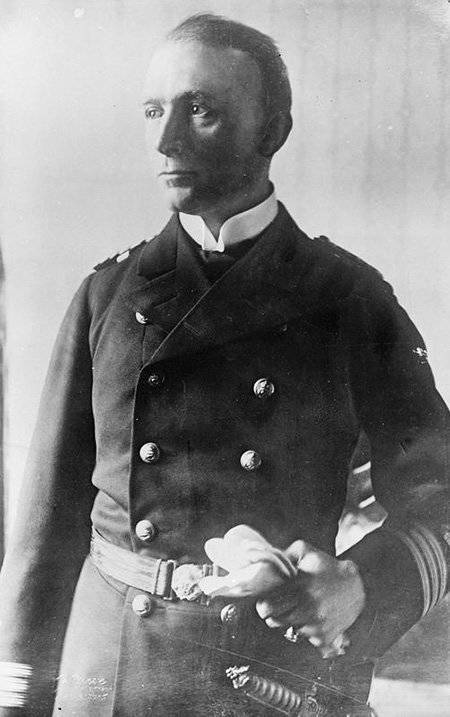
Operatively, Muller’s ship was part of the German East Asian squadron under the command of Vice Admiral Maximilian von Spee. It was based in Qingdao and consisted of the armored cruisers “Scharnhorst” and “Gneisenau”, light cruisers “Emden”, “Nuremberg” and “Leipzig”. Against the Germans, significant forces of the Entente were stationed only in the ports closest to Qingdao: the French armored cruisers Moncalm and Duplex, the Russian cruisers Zhemchug and Askold, the British battleships Minotaur and Hampshire, the British cruisers Yarmouth. and Newcastle, numerous destroyers.
The aggravation of the international situation in June 1914 set the most important task for Vice-Admiral von Spee: not to give the Allies on the Entente and the Japanese to quickly “lock” the German squadron in the Qingdao roadstead in the event of war. To avoid this, von Spee led the main part of the squadron ("Emden" stayed in Qingdao) in a demonstration raid across German Oceania - it was planned to visit the Mariana and Caroline Islands, Fiji, the Bismarck Archipelago, Kaiser Wilhelm Land on New Guinea.
"Emden" is not by chance, apparently, was left in Qingdao: Captain Karl von Muller did not enjoy the special location of the squadron commander. Graf von Spee was a brilliant representative of the German military school, but his views differed significantly from those of von Tirpitz and his pupil von Muller. The commander of the East Asian squadron was not a supporter of the total "economic" war at sea and clearly demonstrated his disgust at the mere idea of using cruisers to fight the civilian transport of the enemy. A representative of the ancient Prussian family, tracing its lineage from 1166, von Spee saw the main task in defeating enemy cruiser units. “Cruisers are fighting with cruisers,” von Spee said to his officers, “leave economic troughs to the gunboats.” At the same time, being a fair and honest person, von Spee highly appreciated the initiative, strong-willed style of von Müller’s command.
On the night of 29 on July 1914 of the year, while on Qingdao’s raid, the captain of “Emden” received a radiogram of the German Naval General Staff: “I suggest“ Emden ”if Plan B comes into effect (meaning war with France and Russia - RP) to go south to Saigon, other ports of Indochina mines, cause difficulties in the implementation of French coastal trade. "
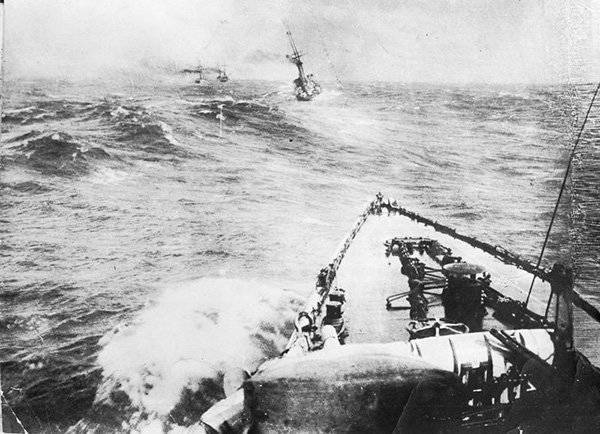
July 30 in the morning 6.30 Senior Assistant Captain Lieutenant Helmut von Mücke gathered all the officers and gave the order to prepare for combat. The sailors were ordered to clean the decks and take seats on the combat schedule. In 19.00 31 July, taking on additional reserves of coal and ammunition, "Emden" left Qingdao, headed for the open ocean to the east - into the Tsushima Strait.
The combat schedule was respected at Emden (as, incidentally, on all German ships) strictly. Each sailor knew that the mine-artillery unit of the cruiser should respond immediately to an unexpected attack of the enemy ships. The guns of the cruiser were pre-positioned in a “combat” position.
At around 2 in the early hours of the night of August 4, forward-looking cruisers discovered the running lights of a twin-tube steamer right on the course. After the 5-hour chase and the tenth warning shot, the enemy vessel slowed down, smoothly sending the SOS signal to the radio. Emden approached the ship and, using the flag mapping semaphore on the foremast, ordered “Stop immediately. Do not give radio signals. A cruiser with a boarding team under the command of Lieutenant Gustav von Lauterbach was launched from the cruiser.
Already a cursory inspection of the steamer and the ship's logs made it possible to determine that Emden received a valuable prize. The vessel was called "Ryazan", belonged to the Russian Voluntary Fleet and followed from Nagasaki to Vladivostok. The ship was of the latest German construction (launched in 1909, in Danzig) and could develop a very significant transport speed at 17 nodes (31 km / h). To sink such a ship was inappropriate.
Above the "Ryazan" raised the German naval flag and took to Qingdao. Here it was quickly converted into an auxiliary cruiser, the Cormoran II (SMS Cormoran). The new ship of the German Navy received the name and guns of an old, already out-of-date raider "Cormoran", who had once taken part in the capture by the Germans of Qingdao.
Cormoran II carried out raider operations in Oceania from August 10 to December 14 1914. Due to the complete production of coal, the raider was forced to go to the port of Apra on the American island of Guam, where he was interned in the flagrant violation of international maritime law. After the US entry of 7 on April 1917 into the war against Germany, the commander of Cormoran II, Adalbert Tsukeshverdt, was forced to order the ship to be flooded. Despite the shooting raised by the Americans, the Germans executed it, killing 9 crew members who did not manage to get out of the holds after the Kingston was opened. The bodies of the dead were raised by American divers and buried with military honors at the Guam Naval Cemetery.
Last conversation with Count von Spee
At 3 in the morning of 6 in August 1914, the cruiser Emden brought the steamer Ryazan (the future Cormoran II) to Qingdao. Cozy, rebuilt according to the German town plan, has changed a lot. Before the war, the Germans grew groves in the vicinity of the port, and now special teams mercilessly cut them down to provide aimed fire for artillery.
The crew of "Emden" did not get fired ashore. By the evening of August 6, taking the cargo of coal, food and ammunition, the cruiser was ready to re-enter the raid. The Governor of Qingdao, Captain Alfred Meyer-Valdek, who later organized the defense of Qingdao against the Japanese, surrendered the port only after the ammunition was fully used to escort the cruiser. The ship's orchestra played a waltz "Watch on the Rhine" - an unofficial anthem of German sailors. The officers stood with their caps off, the sailors together sang along.
12 August near the Pagan Island of the Mariana Islands group "Emden" joined the squadron. The next morning, on the Scharnhorst flagship cruiser, Maximilian von Spee assembled an officer’s meeting to discuss further plans. He himself was inclined to action by the entire squadron in the western Atlantic. When the commander asked the opinion of the commanders of the ships, von Muller said that light cruisers in the squadron would be almost useless, since they could inflict only minor damage on the enemy. Given the shortage of coal and the enormous distance the squadron must travel to reach the Atlantic, von Muller proposed to send one or more cruisers to the Indian Ocean.
In the second half of the day, Commander Emden received a special order from Scharnhorst, delivered by the order of Count von Spee:
“Pagan. 13 August 1914 of the year. Xnumx
Accompanied by the steamer Marcomannia, I order you to change your deployment to the Indian Ocean in order to wage a fierce cruising war to the best of your abilities.
Attached are copies of telegraphic messages from our southern coal supply network over the past few weeks. They indicate the amount of coal ordered for the future - all this coal is transferred to you.
Tonight you stay with the squadron. Tomorrow morning, this order will be triggered by the signal of the flagship "Separate".
I intend to sail with the remaining ships to the west coast of America.
Signature: Count Spee.
Early in the morning of August 14, the German flotilla of 14 ships (a significant part of the coal miners) headed east to the open sea. None of the sailors on the Emden, except for the foreman von Mücke, knew where their ship was heading. Suddenly, the flagship Scharnhorst flagged a semaphore to Emden: “Separate! We wish you every success! ”In response, von Muller conveyed to the semaphore a reply message to Count von Spee:“ I thank you for your trust in me! I wish the squadron of cruisers easy navigation and great success. "
"The Swan of the East" increased the course and turned to the south-west along a wide arc. In the marine 35-multiple stationary binoculars, von Müller clearly distinguished the tall figure of Count von Spee, standing without a cap on an open captain's bridge. Emden's captain did not know what the Count was seeing the last time: Maximillian von Spee would die heroically, along with the main team of his unit, in a truly epic battle with the squadron of British Vice-Admiral Sturdy in the Falkland Islands in the South Atlantic.
Madras Bombardment
Soon a ghost ship appeared in the vast expanses of the Indian Ocean, which shot, undermined, drowned with boarding crews any of the ships of the Entente countries, which had the misfortune of getting caught on its way. At the same time, the life of all the crew members and passengers of these ships was invariably preserved. Captain von Müller, in spite of the hassle, loss of fuel and food, provided for the transfer of prisoners to ships of neutral states or to deliver them to neutral ports. Luckiness and the truly knightly nobility of von Müller could not be denied even by his main enemies, the British.
“We hated Emden in words,” later recalled Lieutenant of the Royal Navy of Great Britain, Joachim Fitzwell, “because panic rumors about an elusive enemy raider fettered transportation in the British island archipelago. However, in the secret depths of the soul, each of us bowed before the luckiness and knightly magnanimity of the captain of the German ship. "
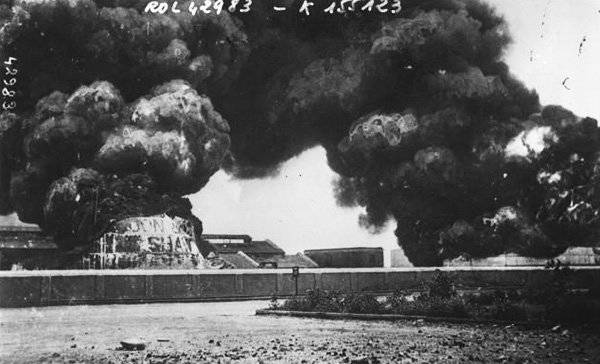
By the middle of September, i.e. just a month after the start of the hunt, the total tonnage (deadweight) of the transport of the Entente countries drowned by Emden approached 45, 000 tons, which was undoubtedly an outstanding result for a single raider.
20 September 1914, Captain von Muller, decided to bomb Madras, one of the largest ports in British India. On a tarpaulin and plywood cruiser, they installed a fake fourth pipe, which created for Emden the silhouette of English light cruisers.
In 21.45, he appeared aboard the Madras and began to enter the harbor, focusing on the non-switched on port lights. After 40 minutes, the Emden was already in 3000 meters in front of the central berths. To the south of them rose huge oil terminals, from which oil was supplied to the port, city and ships. Having turned on powerful searchlights, the gunners of Emden quickly fired, having achieved a storage tank cover from the third volley. The resulting enormous fire burned all the Madras oil. After bringing down a few more volleys at the port artillery positions, Emden turned off the searchlight and disappeared into the blackness of the southern night. A total of about 130 shells were fired around the city and port.
Judging by the reports of British newspapers in India, the shells of Emden brought significant damage: all the oil reserves burned out, the steam communications of the port and the telegraph line were destroyed. The psychological impact of the attack was tremendous: a panic arose, thousands of British and Indians stormed the station.
“The destruction inflicted by Emden’s effective predatory expeditions is very depressing,” wrote an influential newspaper Calcutta Capital a month later, the wildest rumors spread through the bazaars like hurricanes. Even on those who don’t give in to agitation by alarmist people and trust the government, the successful raids of Emden make a deep impression that it is not easy to get rid of. ”
Von Muller, meanwhile, did not even think of giving the sons of Misty Albion at least a small respite. Only from 15 to 19 in October 1914 was the German raider seized seven British ships on the high seas: Clan Grant, Ponrabbella, Benmore, St. Egbert, Exford, Chilkana and Troilus. Five of these ships were sunk. Exford Collier was requisitioned on the naval prize right and the German flag was raised above it. The ship St. Egbert, whose cargo belonged to the United States, was released with all the prisoners and received permission to sail to any port except Colombo and Bombay.
Punishment with careless "Pearls"
The radio intelligence of the Germans in the years of the Great War worked clearly, and in this regard, the radio service of the cruiser Emden was no exception. Based on the analysis of the intercepted radiograms, Captain von Muller concluded that some enemy warships, in particular, the French armored cruisers “Moncalm” and “Duplex” are based at the port of Penang on the island of the same name in the Strait of Malacca. The interrogations of the captured English skippers confirmed that the port lighting and entrance beacons are actually operating in peacetime mode.
The Penang attack operation was carefully designed. The narrow and extensive inner harbor of Penang, which deprived of freedom of maneuvering, presented a particular danger to the warship. The artillery duel with the French armored cruisers was out of the question: in a few minutes the 164-mm and 194-mm guns of these ships could turn the "Emden" into a sieve. Only an exact torpedo shot could tip the scales in favor of the German raider. The operation plan struck with desperate audacity.
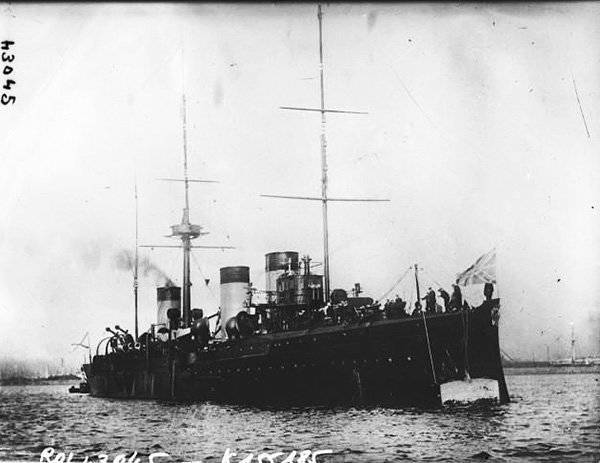
Early in the morning of October 28, putting forth a fourth-pipe fake, turning off the lights and removing the German flag, the cruiser entered the Penang internal raid. Ship watches showed 04.50. The French cruisers, to the dismay of the Germans, were not in the harbor. However, at the far inner pier darkened the bulk of the warship, which was identified as an armored cruiser "Pearl". The Russian ship, along with another cruiser "Askold", was part of the Allied cruiser squadron under the command of British Vice-Admiral Jeram. In Penang "Pearls" was scheduled boilers cleaning.
In 05.18, Emden stepped on a combat course, raised the German naval flag and fired a torpedo shot from a distance of 800 meters. The torpedo hit the "Pearls" stern, but the combat unit of the eight 120-mm cruiser guns could well have opened fire. However, she didn’t open: the watch officer was sleeping sweetly, and the outposts were also apparently resting. The commander of the "Pearl", the captain of 2 rank Baron I.A. Cherkasov at this time rested with his wife who came to him in a hotel in Penang. There was no one to repel the enemy.
Emden's artillery guns brought an avalanche of fire onto the deck and sides of the “Pearl”: in the first minutes of the battle, scores of dead Russian sailors went up. A panic began, part of the sailors rushed overboard. By incredible efforts to the senior artillery officer Yu. Yu. Rybaltovsky and watch officer, midshipman AK Sipaylo managed to open fire from two guns. However, it was too late - the German cruiser again went to the traverse (the direction perpendicular to the board) of the "Pearl" and fired a new torpedo shot.
At this time, the scope was more accurate: the torpedo struck under the conning tower, the explosion detonated the bow artillery cellar. A pillar of smoke and steam blew into the sky — the cruiser broke in half and sank in 15 seconds. The human victims of disciplinary mischief turned out to be terrible: 87 people were killed, injured and drowned, 9 officers and 113 lower ranks were injured.
The Investigation Commission of the Naval General Staff, established upon the death of the cruiser, found guilty in the tragedy of captain 2 of rank, Baron Ivan Cherkasov and senior ship officer, Senior Lieutenant Nikolai Kulibin. They were deprived of “ranks and orders and other insignia”, moreover, “on depriving the nobility and all special rights and advantages” were given to “correctional detention departments of the civil department”. Under wartime conditions, the prison was replaced for Cherkasov and Kulibin by ordinary sailors to the front.
Having destroyed the Pearls, the German raider headed for the harbor exit. The French destroyer Muskte rushed to intercept it, but the German forward-looking people noticed him in time. The raider gunners from the first salvo achieved the cover of the French destroyer, and the third volley was fatal: the boilers exploded on the Musk, he lay down on the water and sank. The Russian lieutenant LL who was in the water. Seleznev later recalled: "In the place of" Musk "a column of black smoke rose, and in a few minutes it was all over."
Despite the need for urgent withdrawal, the commander of the Emden gave the order to stop the vehicles and collected all the surviving French from the water: 36 from the crew members 76. October 30 1914, a German raider, stopped the British steamer “Newburn”, en route from Great Britain to Singapore, and transplanted on board all the captured French sailors.
During the departure from Penang to the wilderness of Emden, the French destroyer Pistol fell in, which did not go on the attack, but every 10 minutes broadcast the coordinates of the outgoing raider, calling on the Allied forces to intercept the German.
The “big hunt”, however, did not work out: after a few hours of pursuit on the Pistol, the main bearing of the propeller shaft began to warm up and the destroyer was forced to slow down. Suddenly, a strong wind and rain hit, and the German raider began to get lost in the haze, and the stormy sea did not leave the wake of the French.
The last battle
Incredible in boldness and luck, the Emden mission, according to the logic of any war, should have ended once. For many days of the brilliant raid, Karl von Muller, most likely due to psychological fatigue for the first time, made a major mistake near the Cocos Islands, which turned out to be fatal.
2 November in a secluded bay of one of the uninhabited islands, Karl von Muller built a crew of a cruiser on the deck disguised in a new uniform. Solemnly played the anthem - 40 sailors "Emden" were awarded medals.
It would seem that everything was developing according to a well-thought-out plan: the next operation was to destroy the radio station and the cable relay station on the Island Directorate, located in the chain of Cocos Islands.
The seizure of the station, undertaken by the German troops on November 9 on the morning of 6.30, was successful. However, before the paratroopers took it, the Australian radio operator managed to broadcast SOS and the message about an unidentified warship. It was received by the flagship of the operational convoy, Australian cruiser Melbourne, which was in the 55 miles. Its commander, captain Mortimer Silver, immediately sent to the Directorate the newest (1912 of the year of construction) high-speed cruiser Sydney armed mainly with eight caliber long-range 152-mm guns.
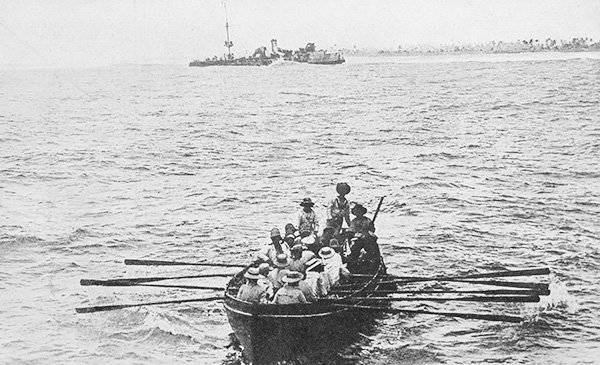
Emden's radio operators intercepted the order from Melbourne, but because of the interference they considered the signal weak and, by its impulse, determined the removal of Australian cruisers to 200 miles. In fact, “Sydney” to the island Directorate remained 2 hours of travel.
Elementary caution dictated the need for care in the open ocean, but von Muller, trusting the technical conclusion of the radio room, ordered to prepare for the loading of coal and called on the previously captured steamer coalminer Bjuresk.
At 9.00, a patrolman on the mast of Emden saw smoke on the horizon, but on the bridge he suggested that the Buresk coal mine was approaching. In 9.12, the approaching ship was identified as a four-pipe English cruiser. An alarm was sounded - an emergency siren, calling for the landing under the command of Lieutenant von Mücke, would return to the ship on the cruiser. I did not have time to do this - in 9.30, Emden raised anchor and rushed away from the island.
But time was lost: Emden’s hull overgrown with sea shells did not allow it to withstand even the design speed in the 23,5 node (43,5 km / h). The newest "Sydney" went at maximum speed in almost 26 nodes, and the "Emden", which stood for more than 3 hours with muted boilers, could not instantly achieve the necessary power of steam.
In 9.40, it became obvious that the Australian cruiser would not be able to tear himself away and the Emden, opening fire, went towards a rapprochement. "Sydney", fearing the famous German torpedoes with a radius of action of about 3,5 km, began to depart - not allowing the distance between the ships to be reduced to less than 7000 meters. At this distance, the 50-mm armor of its armor hull sustained the tears of the 102-mm German projectiles. The gunners from Emden fired, nevertheless, excellently: the back mast was broken on the Sydney, the main artillery rangefinder was destroyed, after the eighth salvo on the Australian ship a fire broke out.
Seeing the flames engulfing Sydney’s stern, Karl von Muller made a desperate attempt to launch a torpedo attack, but the Sydney again departed, taking advantage of its speed advantage.
Australians were shooting longer, but when they achieved the cover, the real raider shooting began. After the next volley the high-explosive 152-mm projectile hit the Emden. "Sydney" went to the most rapid fire, while not allowing the German raider to approach the distance of the effective impact of his 102-mm projectiles. Soon, at the Emden, the electric elevators supplying projectiles from artillery cellars ceased operation. A direct hit tore a chimney at the foremast, which fell on board, and black soot tumbled down onto the deck, hammering glasses of artillery rangefinders, and then the flames engulfed the stern of the raider.
Captain to the end
In 11.15, trying to save the crew, Karl von Muller threw the blazing cruiser into the shallows off the island of North Keeling. Seeing this, "Sydney" stopped shooting. The commander of the "Australian" John Glossop sent a boat to the "Emden" with a doctor and medicines, and then, hoping to capture the German troops, went to the island Directorate. The next day, the surviving officers and sailors from the Emden were taken aboard the Australian cruiser. Total losses at Emden accounted for more than half of the crew: 131 were killed and 65 people were injured.
The landing command of Lieutenant Helmut von Mücke, left on the Island of the Directorate, embarked on an incredible odyssey. The Germans did not wait for the Australian Marines - they seized an old Aisha sailboat on the island and went on it to the open sea. In one of the neutral ports, replacing Aisha with a German coal miner, the von Mücke team reached the port of Hodeid in Yemen. From there, by land, sometimes with battles, the Germans made their way to the borders of Turkey - an ally of Germany in the Great War. In June, the 1915 of the Iron Corsairs, von Mücke, was honored at the German military mission of Constantinople.
Karl von Müller and other members of the raider crew were placed in a prisoner of war camp in Malta. In October, 1916, after the successful escape of one of the officers at Emden, the captain was taken to the UK. In September, 1917, he tried to escape, but was caught and spent, as a punishment, 56 days in solitary confinement.
Malaria, which caught von Muller in the southern seas, was undermining his health. In January, 1918, the physical condition of the Commander Emden became so bad that the British, in view of the already obvious victory in the war, released him to their homeland.
In Germany, Captain von Muller managed to get from the hands of Kaiser Wilhelm II the highest military award - the order "Pour le Merite". At the beginning of 1919, Carl, he retired for health reasons and settled in Braunschweig, in the town of Blankenburg. He lived alone, very modestly, using all his spare funds to help the needy members of the Emden team, first of all those who became disabled by injury.
The heart of the great German corsair stopped in the morning of March 11 1923. He was only 49 years old.
The merits of the surviving crew members were highly appreciated at home - after the end of the war, they and their descendants were awarded a unique honor, getting the right to change their name to double, with the addition of the word "Emden".
Information